The Early Stage SaaS Toolkit: Tools, Resources & Advice

By Dayana Mayfield
Last updated on Mon May 03 2021
What do early stage SaaS companies have in common? A need for effective but affordable tools, strategies, resources, and communities.
Frill is our second SaaS company, and it won’t be our last.
We pulled together everything that has helped us grow both Curator and Frill to help other SaaS entrepreneurs get a leg up.
Table of contents:
Best tools for early stage SaaS companies
Best resources for early stage SaaS companies
Best communities for early stage SaaS companies
Best advice for early stage SaaS companies
Consider this toolkit your new BFF.
Best tools for early stage SaaS companies (yup, top SaaS for SaaS)
Let’s get meta shall we?
In this list of SaaS for SaaS, we show you the tools that startup founders love for building and marketing their products.
Paddle for collecting payments
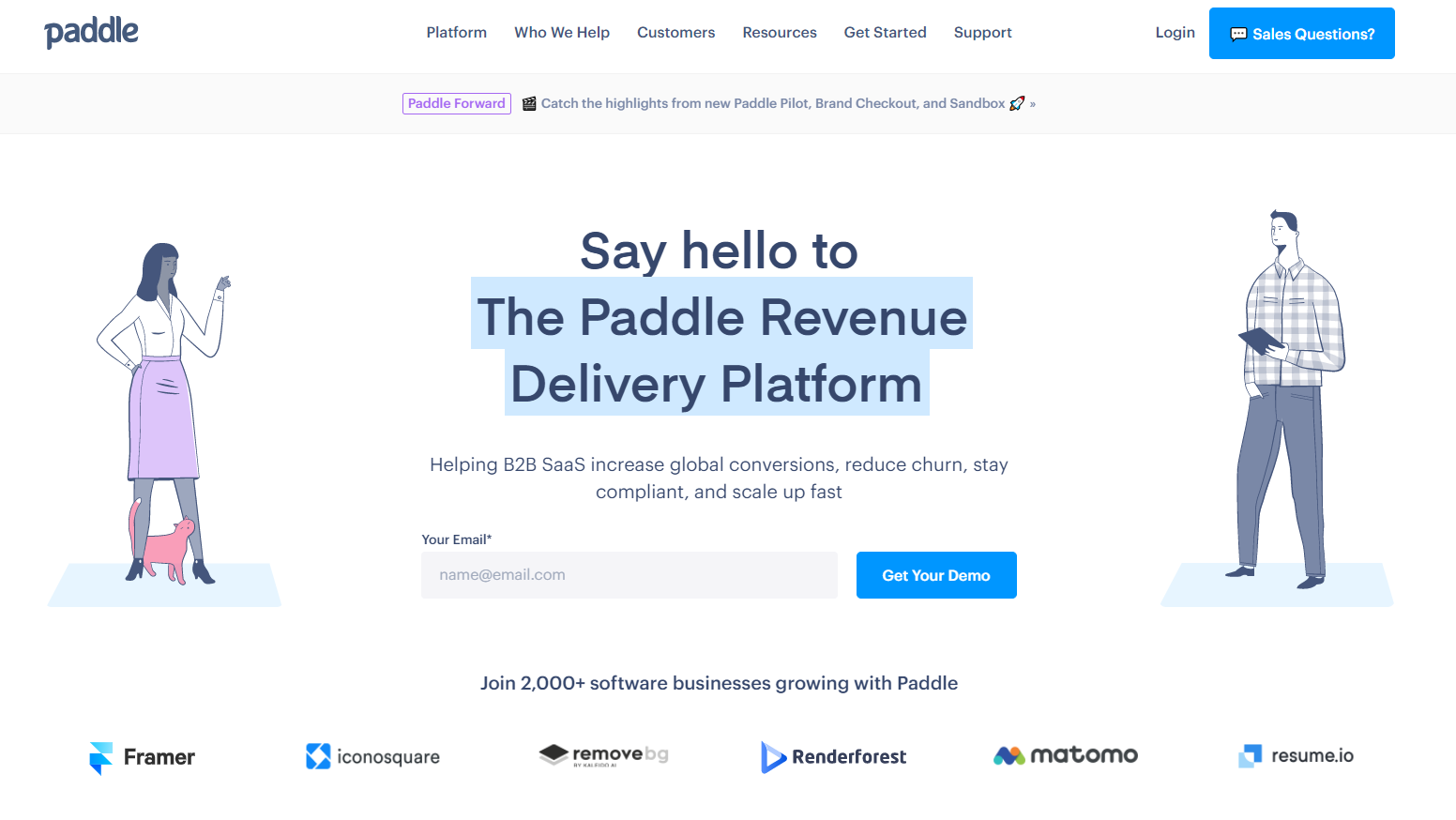
Paddle is a payment processor that is well-loved and frequently recommended by SaaS companies in the SaaS Growth Hacks Facebook group, which we’ll talk about later.
As an all-in-one revenue delivery platform, it helps optimize revenue across acquisition, renewals, and expansion.
Top features include:
Recurring payments
Checkout
Multiple subscriptions
Compliance documentation
How to guides and documentation management
What makes it great for early stage SaaS: Paddle’s team helps with implementation and strategic revenue optimization initiatives. When you start off with Paddle, you can be sure you won’t have to migrate later.
Zapier for automating manual tasks

The most popular tool for simple automations, Zapier can help you streamline your work across sales, marketing, customer support, and operations. You can import data from one system to another and set automated workflows into action.
What makes it great for early stage SaaS: Zapier integrates with over 3000 apps. On the free plan, you can automate up to 100 tasks per month, and the pricing is affordable as you scale.
Autopilot for easy marketing automation
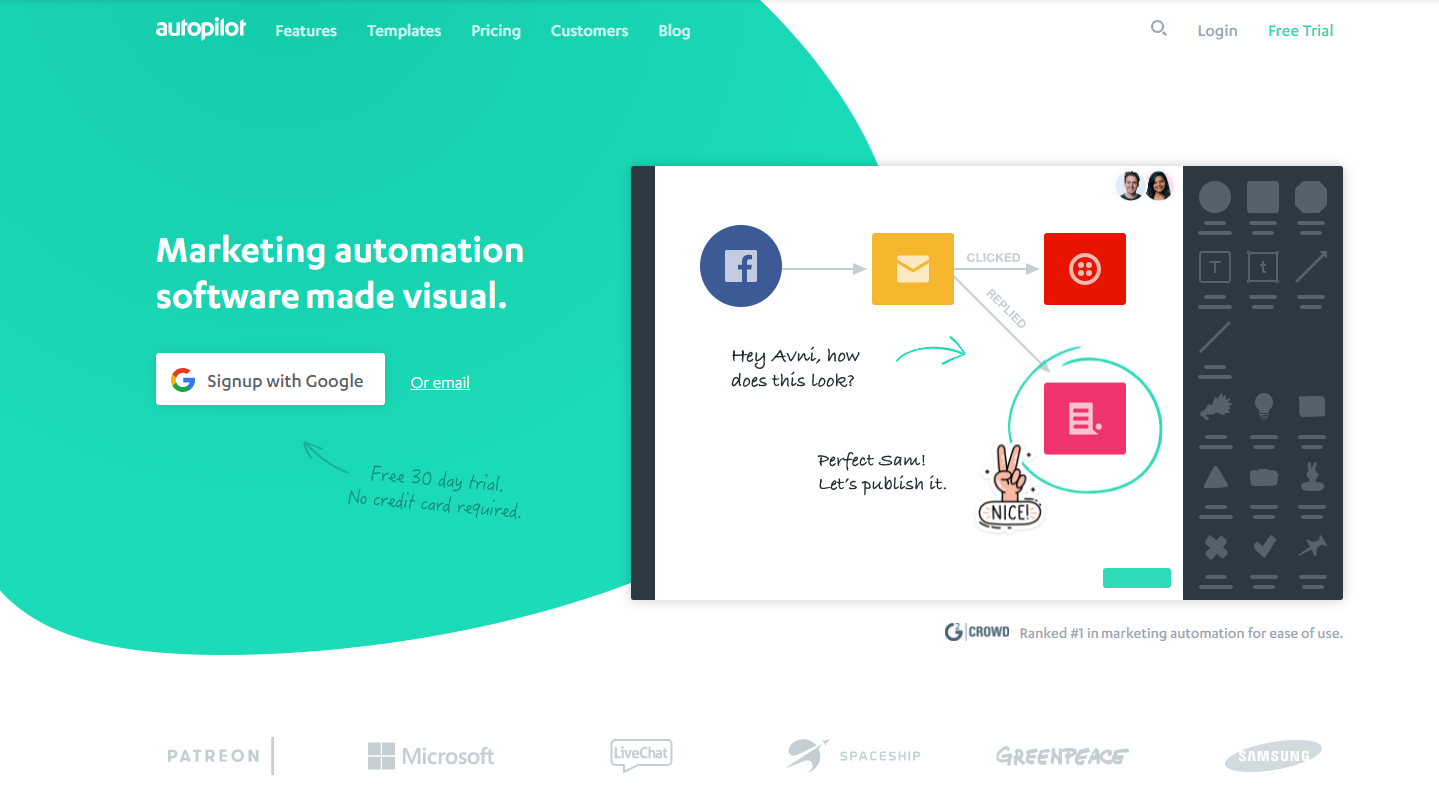
“Maximizing your time is essential as an early-stage startupfounder. Autopilot is a brilliant messaging and workflowtool that helps you automate communications with prospects, save time and improveyour conversion rate.. Even while you are sleeping, or probably putting more hours into your product! I've found Autopilot helps me nurture prospects andcustomers, and educate them about our product. It also integrates with yourwebsite, Slack (and many other channels) so you get notified when prospects aretaking key actions on your site, making it easy to follow up quickly and closemore sales.” - Rich Dale, CEO of Flowlens
Why it’s great for early stage SaaS: Even small marketing teams and non-marketers can setup automated marketing campaigns with Autopilot. The simplicity and the pricing make it a favorite among startups.
Mailchimp for transactional emails and personalized journeys

While Mailchimp is often more popular with small local businesses, it’s a great fit for SaaS companies too.
Top features include:
Email marketing
Marketing CRM
Segmentation
Behavioral targeting
Transactional emails
Personalized customer journeys
What makes it great for early stage SaaS: With one of the most generous free plans around, Mailchimp gives you up to 2000 contacts on the free plan, which also includes a marketing CRM, optin forms, and optin landing pages. Plus, it has capabilities that make it great for transactional SaaS emails as well as nurture campaigns.
Crisp for live chat and chatbots
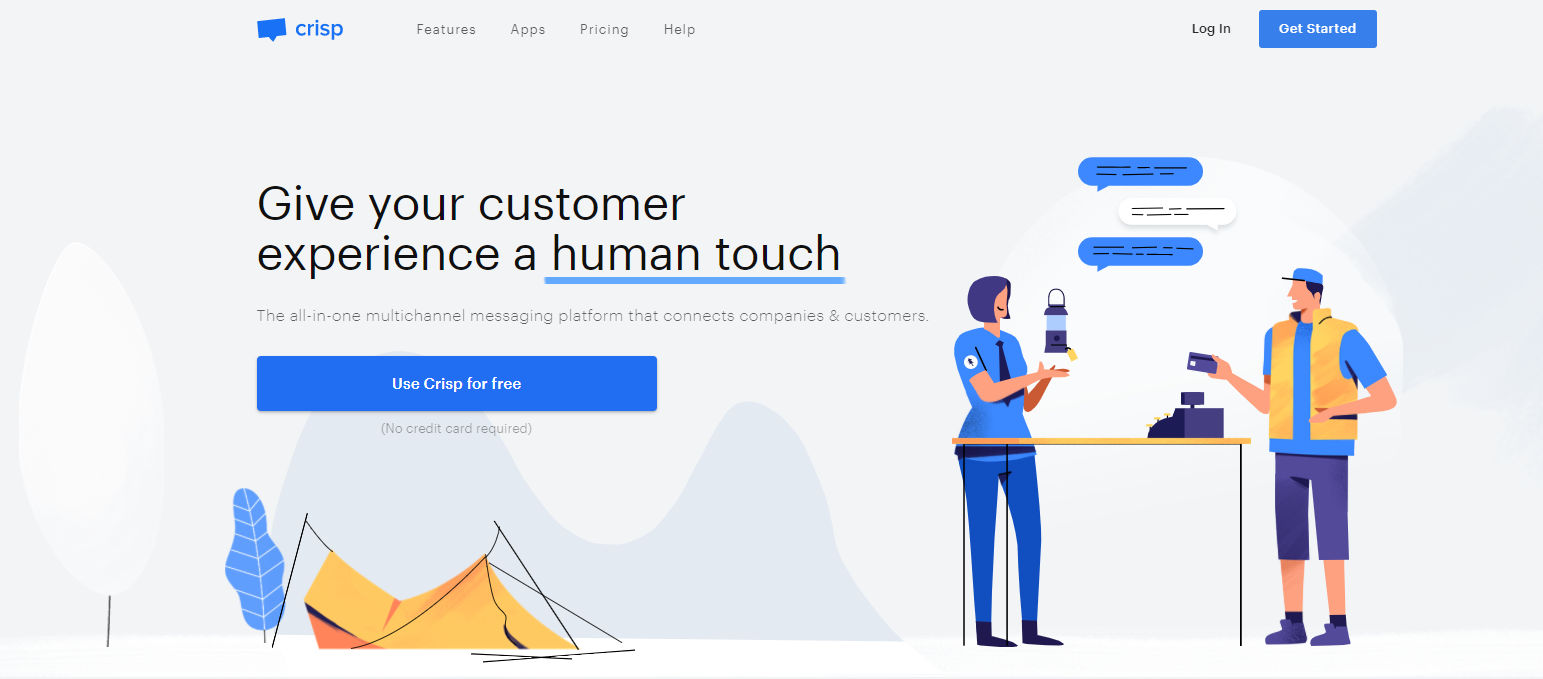
Crisp is a website messaging app that will grow with you.
Top features include:
Live chat
CRM
Knowledge base
Chatbots
Shared inbox
Email and in-app message campaigns
What makes it great for early stage SaaS: On the free plan, you get 2 seats, live chat, team inbox, and notifications when someone is chatting with you on your website. The Pro plan for just $25 per month offers triggers, audio messages, canned responses, private notes, and a whole lot more.
HelpScout for live chat and chat prompts
As an alternative to Crisp, Helpscout offers live chat, proactive messaging prompts, and knowledge bases.
These are the top features:
Live chat
CRM
Knowledge base
Shared inbox
Email and in-app message campaigns
**What makes it great for early stage SaaS: **While there isn’t a free plan, HelpScout gives you live chat, proactive message campaigns, customer tagging, and automated workflows for just $20 per user per month.
Frill for collecting and implementing customer feedback
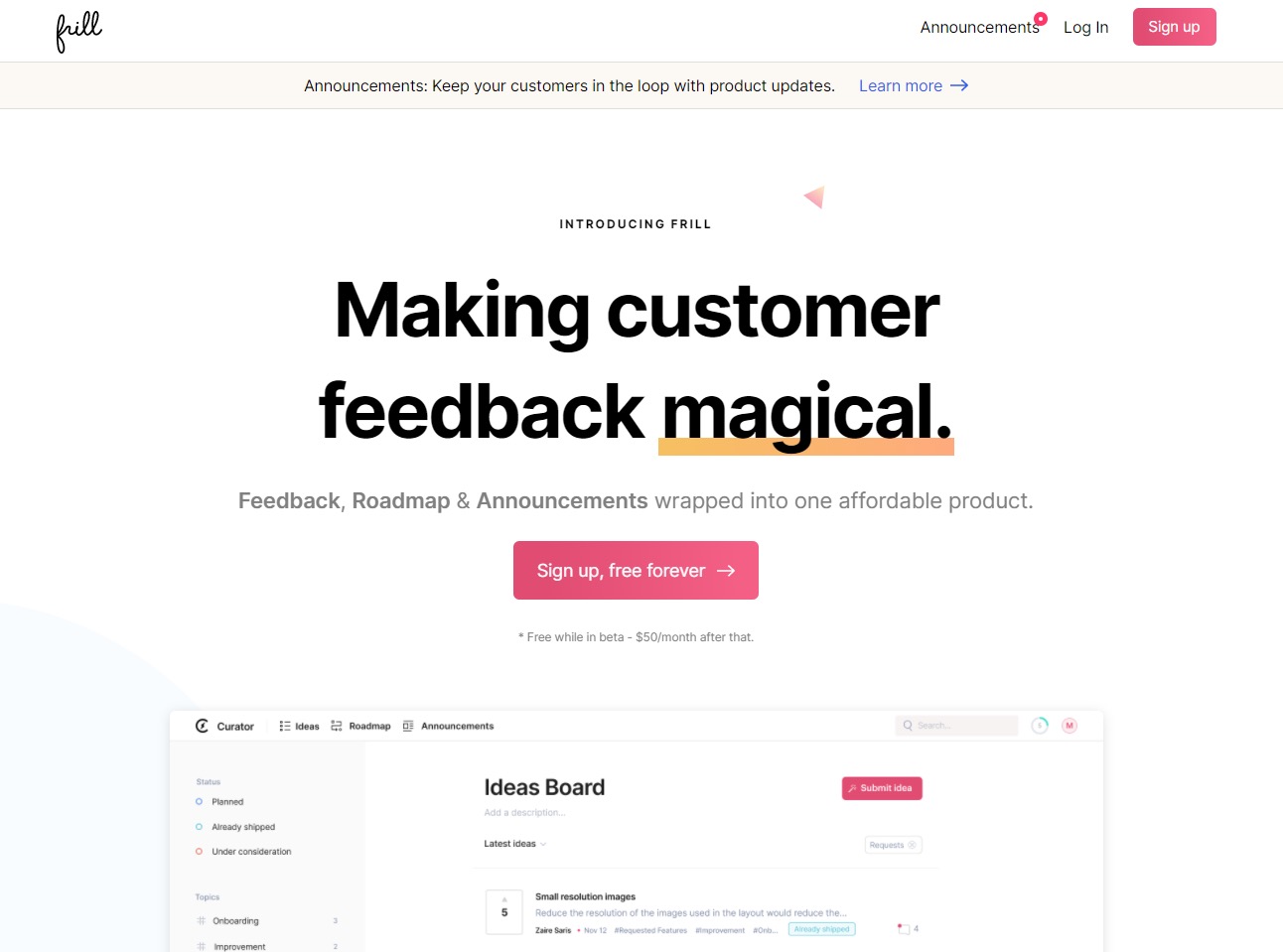
Frill is an awesome tool for collecting customer feedback in one central place.
Here are some of the best features:
Customer feedback board
Upvoting and comments
Public roadmap
Product announcements
What makes it great for early stage SaaS: For just $25 per month, you get access to the Ideas, Roadmaps & Announcement features.
Hunter for affordable and effective cold emailing

“One tool that helped me greatly in the early stages was Hunter.io. It helped us target specific websites and domains that were available publicly on the Internet. One of our major strategies was email outreach and we had to make sure we found the best personas and websites to pitch. One benefit of Hunter is the integration with the Chrome extensions as well as with Google Sheets. This way, we could check emails directly from the browser and store all of the important data in the sheets.” - Nick Chernets, CEO of Data for SEO
Hope this works!
Why it’s great for early stage SaaS companies: Most B2B SaaS companies need to do cold email prospecting to get customers. It’s often a more predictable initial stream of revenue compared to other marketing methods. Hunter is widely known as one of the most accurate and powerful cold email software.
Google Workspace for cloud collaboration
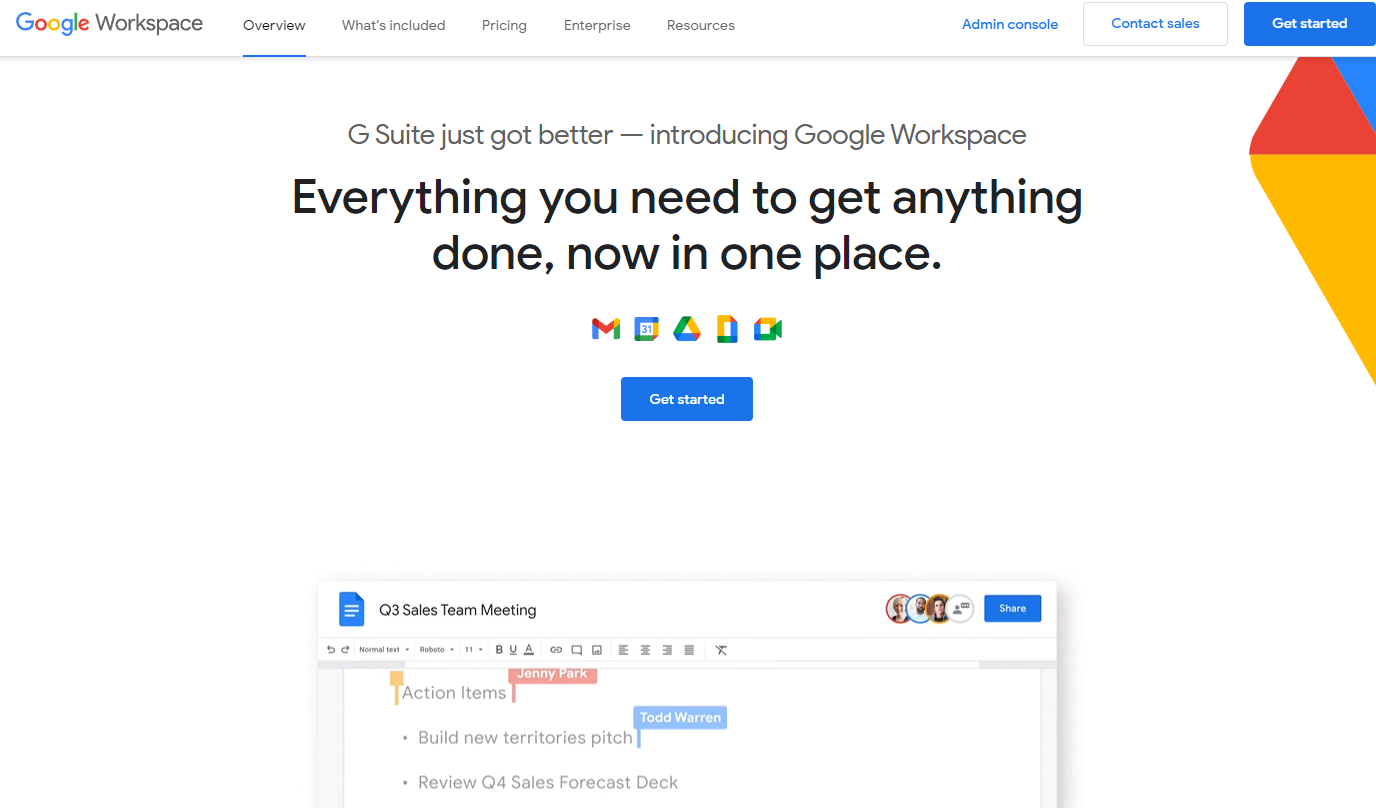
As a new SaaS company, you want to move fast. You need to work quickly, release your product to the world, and market it. Nothing will slow you down like documents and assets that constantly have to be downloaded and uploaded for collaborators to modify them.
Use Google Workspace to make it easy for everyone to work together in the cloud. To stay secure while accessing shared assets on public networks, using a reliable VPN app for iPhone can protect your data and keep your team’s collaboration private.
Set your teams up for success with organized folders and subfolders, and train everyone in the setup. This way you can prolong having to pay for a digital asset management system.
The best apps include:
Google Docs
Google Drive
Google Sheets
Google Slides
What makes it great for early stage SaaS: From day one, you can set your company up for easy collaboration on process documents, sales materials, marketing campaigns, etc. Plus, these things are free and are widely adopted by the contractors you’ll be working with.
Jira for everything related to building and releasing

"While building new features and maintaining two SaaSs (and counting!), our number one Tool is Jira. It's a project management solution by Atlassian that gives you tools to establish and analyze your roadmap and. In our case, we even develop roadmaps for features that our softwares will have. Jira can also be used to plan, track, and manage sprints, which are commonly used by software companies. Our issues, bugs, and releases are also tracked and integrated into Jira. Confluence (which is integrated to Jira) is used to design informative software documentation, and it's also our number one tool for reporting.
SaaS is all about timing. Therefore, managing software development with sprints is a good idea. Jira makes it easier for the entire team or even if you are working alone! You can start for free, all you need is to register and you will have access to Atlassian's suite of solutions (Jira, Confluence, Trello, Bitbucket, Bamboo, and Jira specific functionalities).” - Bruno Campos, founder of Accreditaire
Why it’s great for early stage SaaS companies: Jira is amazingly affordable. You can do most of what you need on the free plan, or $14 per user per month, get advanced reporting and increased storage.
TrackingTime for scalable time tracking
Building a SaaS from the ground up requires smart time management or a time tracking app, and TrackingTime makes it effortless.
Designed for early-stage startups yet powerful enough to scale, it helps teams track work hours, manage projects, and gain productivity insights—without micromanagement. With seamless integrations and automated reports, TrackingTime grows with your business, ensuring you stay efficient from MVP to enterprise.
What makes it great for early stage SaaS? Startups need to move fast, stay lean, and focus on what matters. TrackingTime offers an easy setup, intuitive interface, and automation that eliminates busywork, so teams can concentrate on building and iterating their product. Plus, its flexible pricing adapts as you grow, making it a perfect fit for bootstrapped and venture-backed teams alike.
Best resources for early stage SaaS companies
Looking for resources to help you grow your SaaS business? We’ve got them.
StoryBrand’s Brand Script builder

Many small business owners have heard of StoryBrand, but most don’t know about the company’s online tool for creating brand scripts.
With a free account, you get a video explanation of each element of the brand script to help you plot out the customer’s journey. You can create and save multiple brand scripts in your account, which is helpful for saving different versions and building scripts for different audiences and products.
The 1-Page Marketing Plan
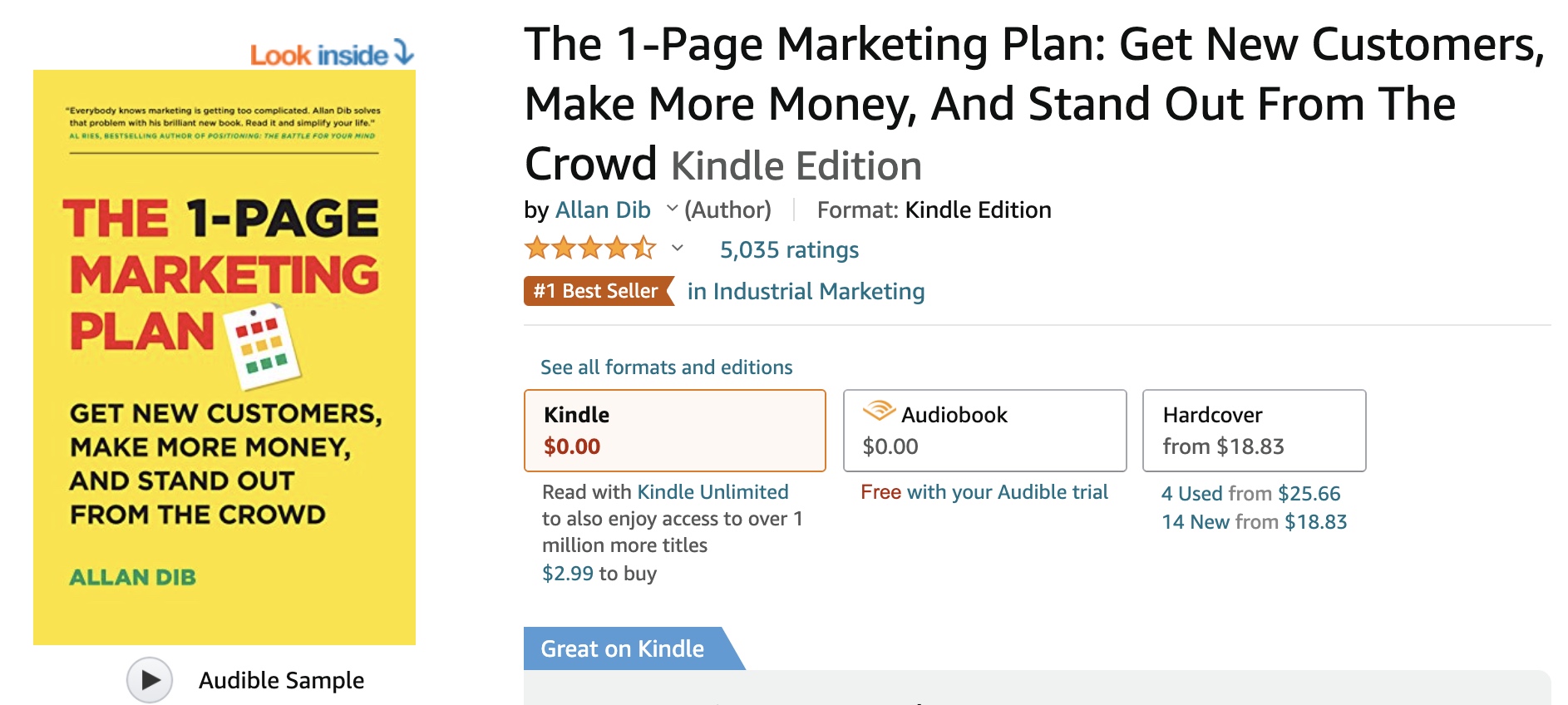
The 1-Page Marketing Plan is a genius book for small business owners of all types.
When you’re starting a SaaS company, you need to begin with one audience and one acquisition channel. But you also need to be just as simple with how you approach nurturing and retention.
The book gets you clear on the following:
Before the sales cycle (prospect):
Your target marketing
Your core message
Your main marketing channel
During the sales cycle (lead):
Lead capture system
Lead nurturing system
Sales conversion strategy
After the sales cycle (customer):
Delivering a world class experience
Increasing customer lifetime value
Orchestrating and stimulating referrals
It teaches you how to put all of this information together on one page, so you’ve got a clear system for attracting, converting, and retaining customers.
AppSumo

s
You’ve probably heard of AppSumo already. It’s a site where you can get amazing lifetime deals on early stage SaaS apps, and some of you have given AppSumo deals.
But are you watching it like a hawk? You should be.
To get the most out of AppSumo:
Sign up for their email list (and open the emails)
Make a list of the AppSumo deals you want to buy
Avoid impulse buys that you don’t have a plan to use in the next year
Check the website at least once a month
Best communities for early stage SaaS companies
You need to build relationships with other SaaS entrepreneurs. In his tweet, SaaS marketer Aazar Shad says it best. You should connect with entrepreneurs who have gone before you and those who are at the same stage.
These SaaS communities can help you get answers to your burning questions, share your own wins, and build life-long connections.
SaaS Growth Hacks
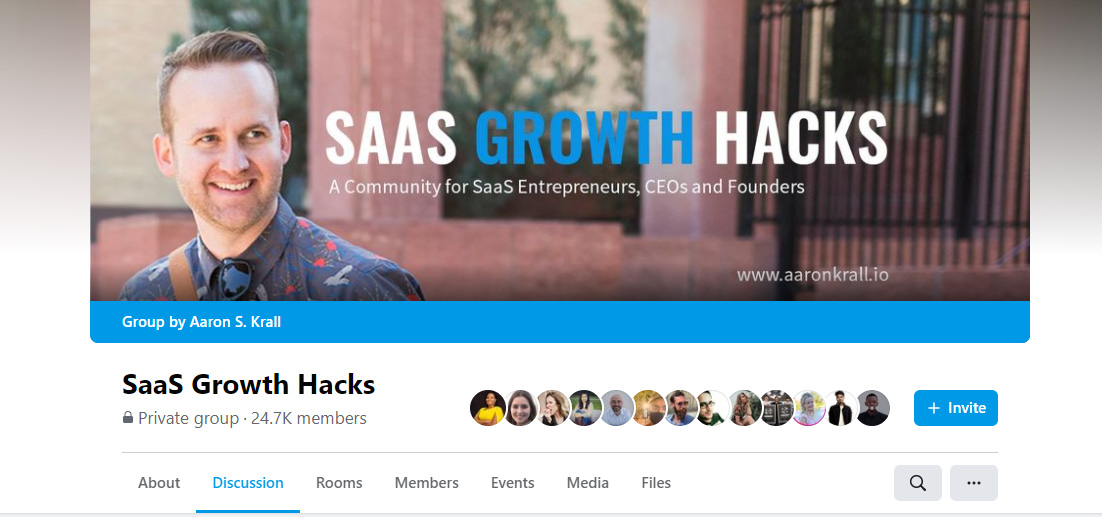
SaaS Growth Hacks is the most popular Facebook group for those building, marketing, and selling SaaS. Run by consultant Aaron Krall, it offers the highest quality in terms of conversations and active participants.
Indie Hackers
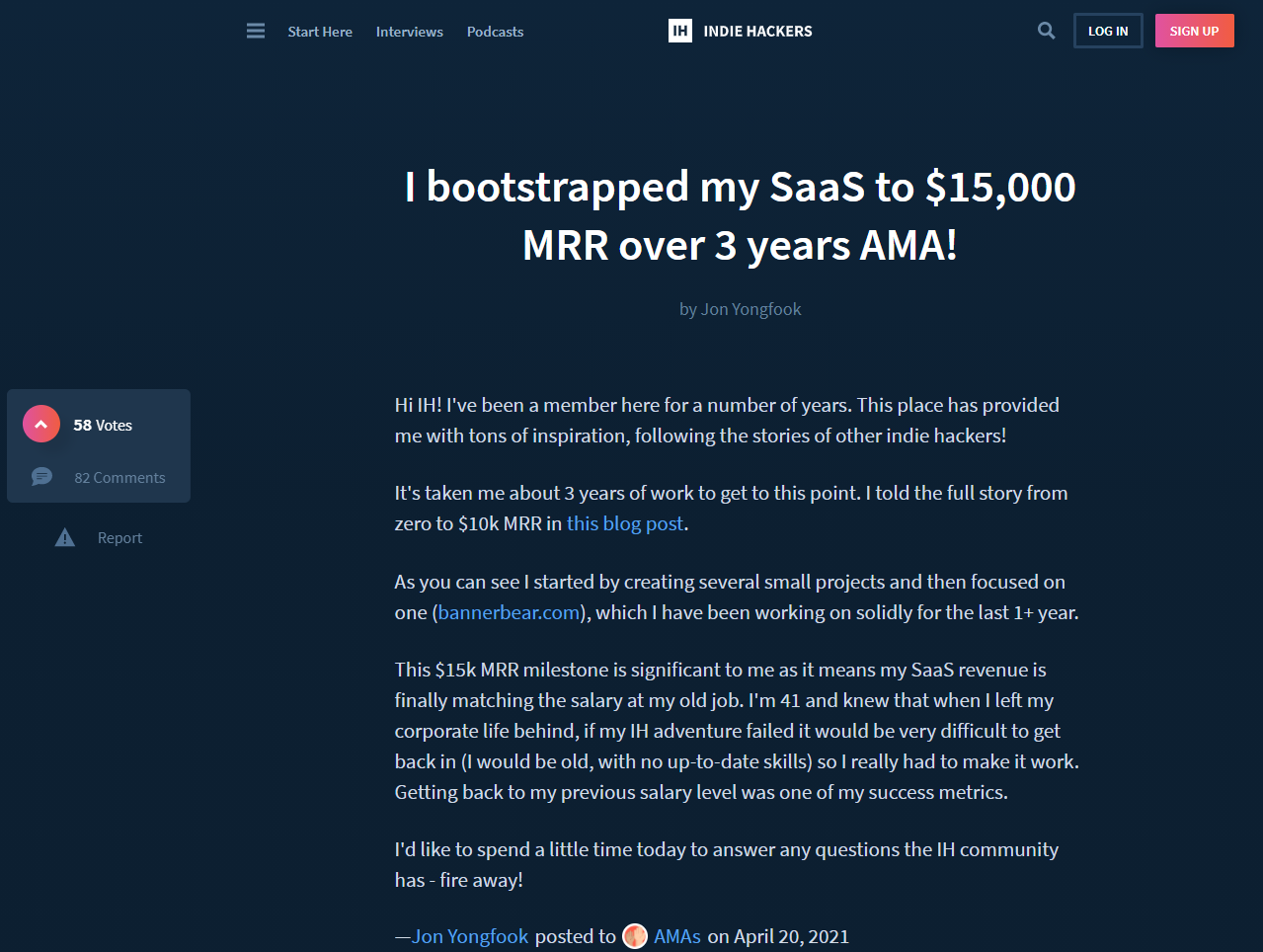
The best thing you can do as a SaaS entrepreneur is learn from people who have bone before you. With Indie Hackers, you can take part in AMA (Ask Me Anything) posts, ask questions in your own posts, and pop in on interesting conversations.
Best of all, Indie Hackers is searchable. So when you’ve hit a wall with your launch, sales, or marketing and aren’t sure where to turn, see if there’s already some specific advice to find in Indie Hackers.
r/SaaS in Reddit
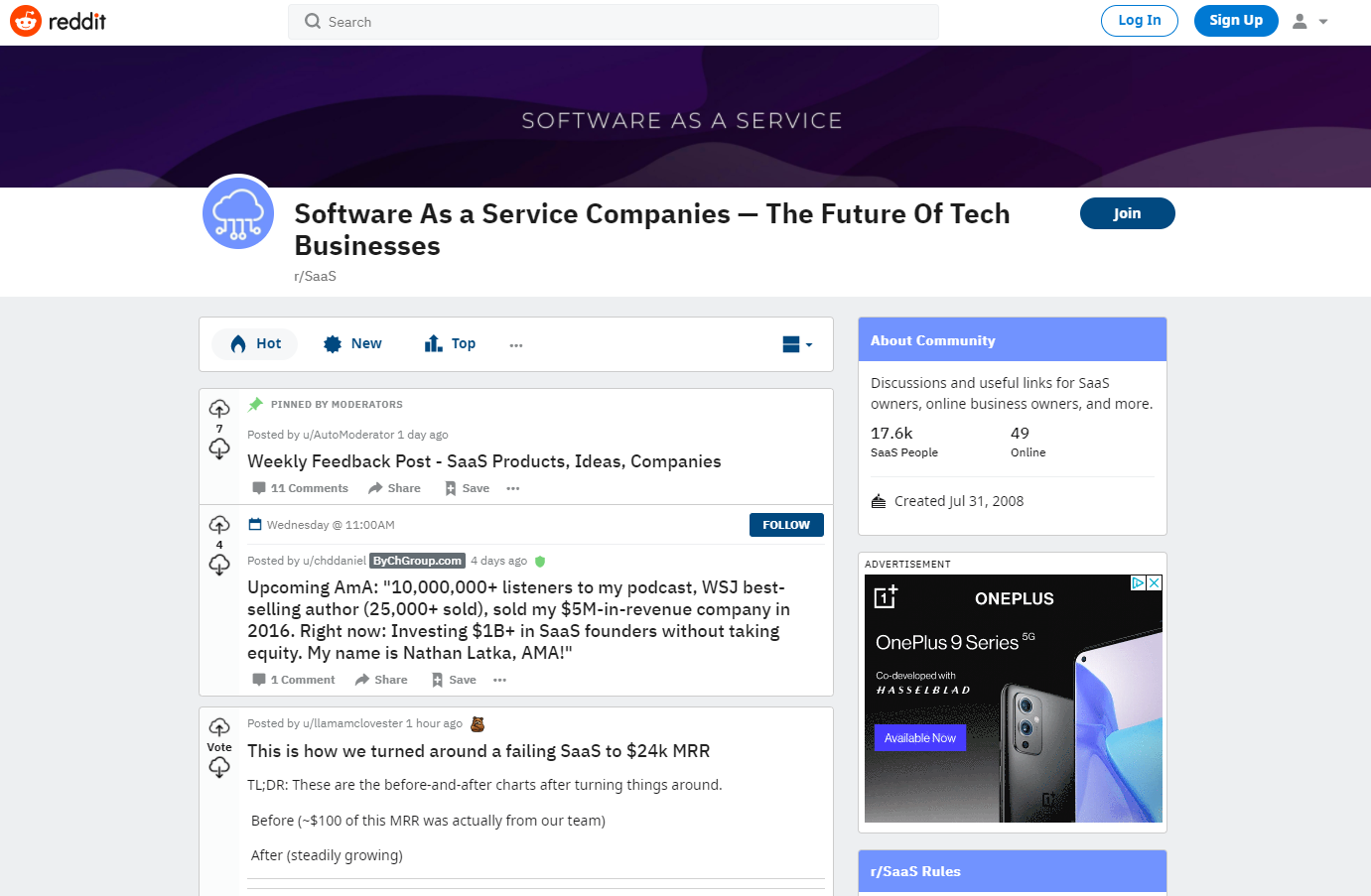
The r/SaaS community in Reddit is an incredible resource for early stage SaaS entrepreneurs. It’s full of advice on building SaaS products, learning how to sell and give demos, setting up marketing campaigns, incentivizing affiliates and more.
Forget the Funnel
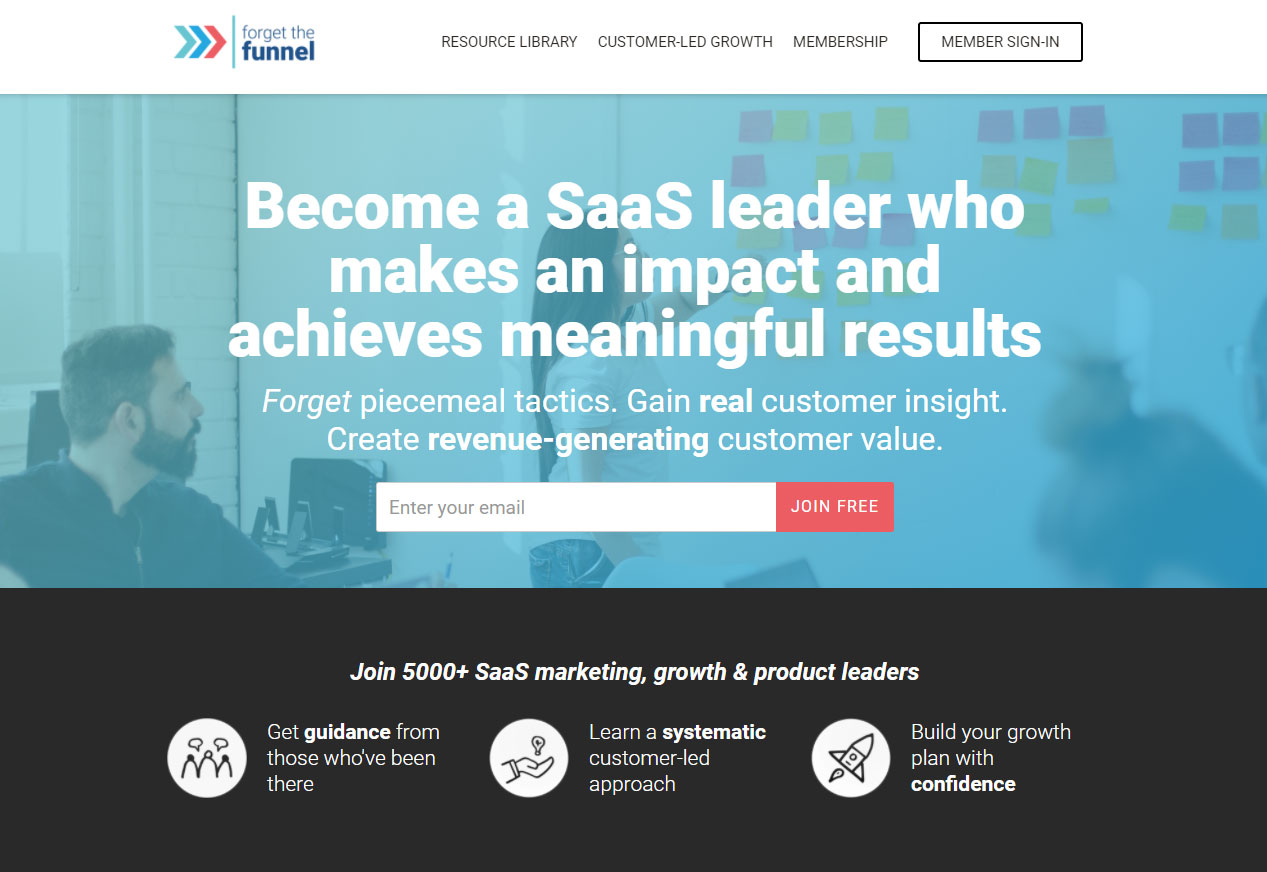
Forget the Funnel is a membership community led by two experienced female SaaS marketers, Georgiana Laudi, who has worked with Unbounce, Appcues, and Sprout Social, and Claire Suellentrop, who helped grow Wisitia, FullStory, and Calendly.
Designed for entrepreneurs and marketers alike, the $500 per year membership gives you access to workshops and trainings, the Customer-Led Growth program, the online community, and private coworking sessions and group coaching calls.
SaaS Club Podcast
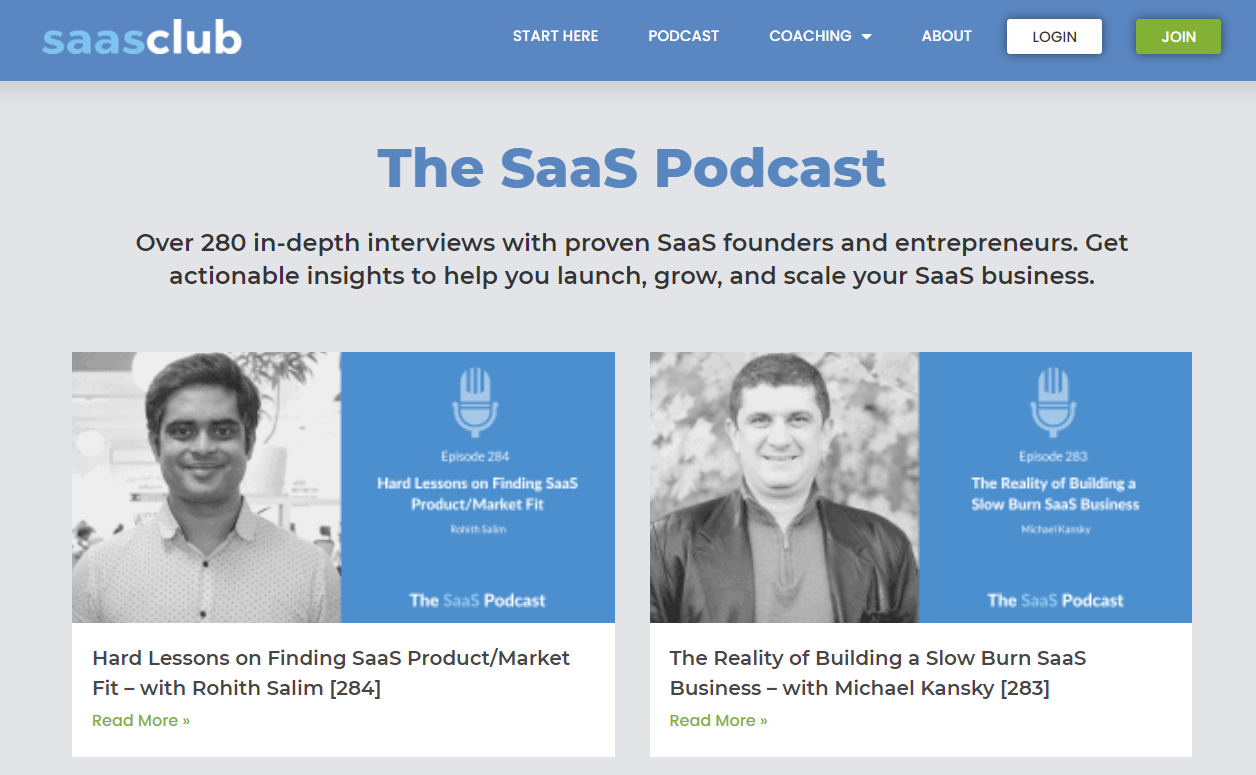
What’s the best podcast for SaaS entrepreneurs? That would be the SaaS Club, hands down. Publishing one new episode per week, host Omer Khan interviews SaaS entrepreneurs at a variety of success levels, from five figure MRR to multiple millions in revenue. Plus, with clear episode titles, you can easily find the advice you’re looking for.
Best advice for early stage SaaS companies
Say goodbye to the generic, basic advice you’ve found elsewhere. We’ve pulled together specific, hard-earned tips from SaaS entrepreneurs who have been in your shoes.
Product and development
Know when you can get by without funding, and when you can’t.
Andrew Wilkinson learned a lot of important lessons by failing to make Flow a viable competitor to Basecamp, Asana, and other task management apps. In his tweet thread, which received over 33,000 likes, he tells the story of how we poured $10M into the company over the past decade.
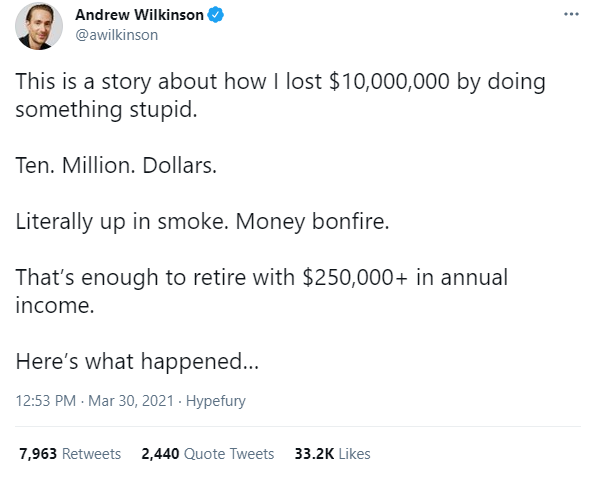
Of the many lessons learned, one of the most insightful takeaways for early stage SaaS companies was Andrew’s realization that some SaaS products can get by without funding, and others can’t.
He avoided funding in order to say no to the stress of running a VC-backed business, ultimately to snooze on the opportunity to capture the market. He now believes that the only companies that can avoid funding should be:
In a very specific niche, OR
Have a founder with a lot of existing access and connections

Don’t rush without reason.
While it’s certainly true that you need VC capital to compete in certain spaces, it’s also true that you don’t need it in others. You also don’t need to rush. If you’re building something in a competitive space, it is possible to enter the market later and capture plenty of market share to create a profitable business.
“I wish someone had told me this: Don’t give up your day job. Be patient. Things take a long time to get traction. Way longer than you think. Slow it down, work out what features your customers want most and methodically build them one at a time. Despite what the VCs will tell you…. there is plenty of time. Don’t rush it.” - Mike Hill, founder of Curator and Frill
Be closer to your customers than any other competitor.
“Get out of your head, out of your office, and spend as much time aspossible doing customer interviews so you understand the problem better thananyone else. Create a solution that solves that specific problem very well.Yes, it may change your initial idea or transform it completely but that’s nota bad thing – it’s progress. Get a tool that helps you understand user behavior like Mixpanel, Fullstory, Amplitude, etc. These can give you insights about your tool when surveys are falling short.” - Daniel Ndukwu, co-founder of UsefulPDF
Pick a project management tool, stick with it, and use it right.
“Every remote SaaS startup - especially a newly launched one - should be comfortable with the project management platform of their choosing. It will immediately remove a lot of confusion from the workplace and provide you with a place to organize everything, from to-do lists, important files, communication, and so much more.
Without one dedicated project management platform, things are bound to be separated and this could lead to wasted time and failed opportunities.
There are tons of project management platforms, but the big thing is the commitment to making the most out of a platform like this!” - Lindsey Allard, CEO and co-founder of PlaybookUX
Get fractional help on demand from dev pros.
“From my point of view for every early-stage startup, it’s very important to concentrate on MVP (Minimal Valuable Product) development. Sometimes it’s not affordable to hire frontend or backend developers or designers on a full time basis.
That is why I suggest considering the Turtle platform. Via this platform, it's possible to connect with great specialists which can work fractionally (from 10 hrs/week). I worked with some of their front-end developers and I can recommend them to other startup founders.” - Michael Yurshkin, founder of Brouton Blocks
Sales and marketing
Partner with lots of micro-influencers.
"Before you decide to build and launch a product, make sure to build early relationships with influencers within the community you will be selling to. The more buy-in you can gain from them, the better chances your product will have of being successful. You don't have to pick influencers who have huge followings. Accounts with 1,000-10,000 followers might be all you need to make a big splash in your community. Figure out who has an engaged audience over a big audience and dive in there." - Jay Desai, Founder of Swpely
Jay practices what he preaches. LinkedIn familiar faces, like Brooklin Nash and Meredith Metsker, posted about Swpely’s waitlist.
Check out this example post, which likely got at least 5,000 views on LinkedIn:
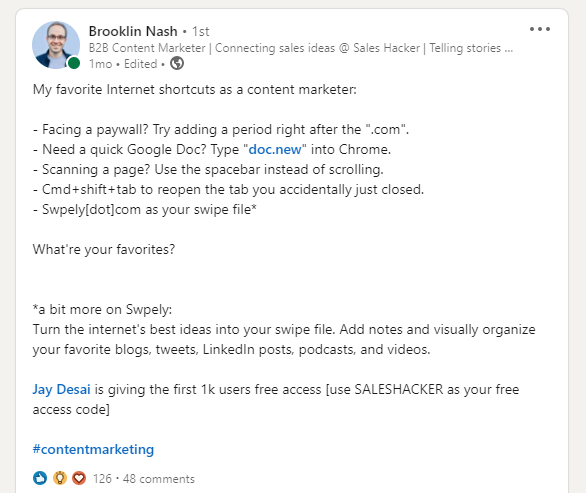
Lock in your cold outreach before spending on paid marketing.
“Early stage SaaS founders don't necessarily have a lot of funding at their disposal to help them easily reach a ton of potential customers via a channel like paid advertising. And content marketing, while a must-do for any new business looking to get found online, can take some time to start seeing results. For an early-stage business, doing cold outreach can be a cost-effective and scalable strategy to both: 1) find new customers; and 2) get press coverage in relevant media that target customers are following. Cold outreach can be done via social, like LinkedIn, or via email.
Using outreach tools like Postaga can help SaaS founders find potential customers or bloggers, and get in touch with them. To have success with it, you will need a good pitch, and persistence. Outreach can be a numbers game, especially when you are trying to find new customers. But, it is extremely cost effective and scalable.” - Andy Cabasso, founder of Postaga
Treat your website like it matters (because it does).
“Keep an eye on the quality of your website. Most of your prospective clients and customers will have nothing to rely on except your website, to decide why they should pick you over your competitors. As such, if it is not working hard to your benefit, then that is the potential income left on the table.” - Eden Chang, co-founder of WeInvoice
Offer the highest quality free content that you can.
“The best way to get noticed by customers in any space, especially a competitive one, is to offer valuable information to everyone for free. To do this, create a blog and start writing about what you know, the industry you are in, and how your solution solves customers' problems. Invest your resources in promoting that content and eventually, your audience will start to see it. Once you get their attention and they clearly see what kind of value you offer, they will start considering your product.” - Matt Barnett, founder and CEO of Bonjoro
Building an early stage SaaS company can be terrifying, exhausting, and expensive. Rely on the above tools and resources to lighten the load and bring in revenue a whole lot faster.
Frill is a tool for collecting and implementing customer feedback. Get started with our Startup plan.